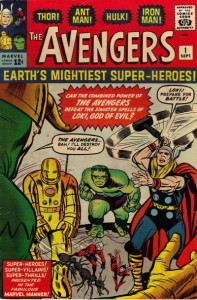 I knew it had been a while since we did one of these back-room-special posts, but when I checked the archives I was surprised that the last one was way back in early October. It’s not that I haven’t been working on backstock; it’s that Batman comics took a long time to sort, and then while we put them out in early December I never did a post on them, and now for the last month and a half or more I’ve been working on Avengers comics. It turned out that we had 17 long boxes (or almost 6,000 comics’ worth) of unsorted Avengers books, representing the various titles in that franchise that have been published since June 2008, the last time they were integrated into the main backstock, or bought as back issues by us since then. Finally, though, they’ve been sorted and priced and culled
I knew it had been a while since we did one of these back-room-special posts, but when I checked the archives I was surprised that the last one was way back in early October. It’s not that I haven’t been working on backstock; it’s that Batman comics took a long time to sort, and then while we put them out in early December I never did a post on them, and now for the last month and a half or more I’ve been working on Avengers comics. It turned out that we had 17 long boxes (or almost 6,000 comics’ worth) of unsorted Avengers books, representing the various titles in that franchise that have been published since June 2008, the last time they were integrated into the main backstock, or bought as back issues by us since then. Finally, though, they’ve been sorted and priced and culled (at least all the ones in the flagship title), and now they’re available.
(at least all the ones in the flagship title), and now they’re available.
Given the long time, let’s start with the standard recap: I’m slowly going through AABC’s one-million-plus back-issue room, restocking the boxes on the sales floor and pulling stuff to sell as discount/overstock/special items. I’m going through the alphabet backwards (don’t ask), and at my speed (especially with school in session), this amounts to a three-year-plus project. This week, we’re featuring Marvel’s premiere superhero team: The Avengers.
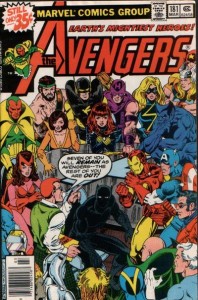 As anyone reading this article probably already knows, The Avengers started back in 1963 — but we don’t have any of those early issues out at a discount (although most issues from around #10 up are newly graded, priced and available as part of our regular store stock now). On the discount racks, there are a couple of scattered issues from the Steve Englehart/Sal Buscema/George Perez era (roughly from #110-150), from the Jim Shooter-scribed run that followed (from around #158-176), and from the David Michelinie/John Byrne run that followed that (from #181-191), but the consistent, more complete overstock bargains start with issue #201 (still written by Michelinie, and drawn by George Perez,
As anyone reading this article probably already knows, The Avengers started back in 1963 — but we don’t have any of those early issues out at a discount (although most issues from around #10 up are newly graded, priced and available as part of our regular store stock now). On the discount racks, there are a couple of scattered issues from the Steve Englehart/Sal Buscema/George Perez era (roughly from #110-150), from the Jim Shooter-scribed run that followed (from around #158-176), and from the David Michelinie/John Byrne run that followed that (from #181-191), but the consistent, more complete overstock bargains start with issue #201 (still written by Michelinie, and drawn by George Perez, 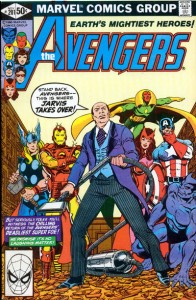 with an amusing Jarvis-themed cover) on up. The same team contributes an Ultron story in #202, with Carmine Infantino taking over the art chores on #203, Don Newton (the Phoenix-born artist most known for his DC and Charleton work, in a rare Marvel appearance) on #204, Paul Kupperberg on #205, and then the great Gene Colan on issues #206-208 and #210-211. Shooter returns as writer with #211, and journeyman penciller Bob Hall contributes to #213 and 214, with the former kicking off a controversial plot involving Hank Pym, embittered and increasingly violent, turning on the Avengers and his then-wife, and the latter
with an amusing Jarvis-themed cover) on up. The same team contributes an Ultron story in #202, with Carmine Infantino taking over the art chores on #203, Don Newton (the Phoenix-born artist most known for his DC and Charleton work, in a rare Marvel appearance) on #204, Paul Kupperberg on #205, and then the great Gene Colan on issues #206-208 and #210-211. Shooter returns as writer with #211, and journeyman penciller Bob Hall contributes to #213 and 214, with the former kicking off a controversial plot involving Hank Pym, embittered and increasingly violent, turning on the Avengers and his then-wife, and the latter 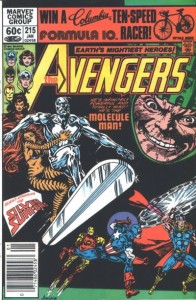 featuring an interesting take on the Ghost Rider. Issues #215 and 216, drawn by Alan Weiss, involve Shooter’s first shot at writing about the Molecule Man, an absurd Lee/Kirby villain that he recrafts into a fascinating portrait of a little nerdy guy given cosmic power, a character and theme that he’ll return to later in Secret Wars and its sequel. Hall returns for #217 and 219-221, and after a few issues of creative-team shuffling Roger Stern comes aboard as writer with #227 to begin a long tenure, with Sal Buscema on his initial issue, then Al Milgrom on issues #228-230 (which resolve the Hank Pym story in a dramatic and satisfying way), and
featuring an interesting take on the Ghost Rider. Issues #215 and 216, drawn by Alan Weiss, involve Shooter’s first shot at writing about the Molecule Man, an absurd Lee/Kirby villain that he recrafts into a fascinating portrait of a little nerdy guy given cosmic power, a character and theme that he’ll return to later in Secret Wars and its sequel. Hall returns for #217 and 219-221, and after a few issues of creative-team shuffling Roger Stern comes aboard as writer with #227 to begin a long tenure, with Sal Buscema on his initial issue, then Al Milgrom on issues #228-230 (which resolve the Hank Pym story in a dramatic and satisfying way), and  continuing through #232. John Byrne guest-pencils #233 (a crossover with his Fantastic Four #256), and then Milgrom returns for a while, including a nice Spider-Man guest appearance in issues #236-237, and the infamous (and strange) #239, with features the Avengers on the David Letterman show (this back in 1984, when Letterman was still (a) young and (b) cool). Issues #242 and 243 are a Secret Wars crossover, and set up a long-running subplot involving the Vision, while #s 246-248 feature the Eternals (and introduce Sersi, who will become an Avenger for a while) and #249 crosses over with Walt Simonson’s Thor #349. Issue #250 is Milgrom’s last, with Bob Hall returning for
continuing through #232. John Byrne guest-pencils #233 (a crossover with his Fantastic Four #256), and then Milgrom returns for a while, including a nice Spider-Man guest appearance in issues #236-237, and the infamous (and strange) #239, with features the Avengers on the David Letterman show (this back in 1984, when Letterman was still (a) young and (b) cool). Issues #242 and 243 are a Secret Wars crossover, and set up a long-running subplot involving the Vision, while #s 246-248 feature the Eternals (and introduce Sersi, who will become an Avenger for a while) and #249 crosses over with Walt Simonson’s Thor #349. Issue #250 is Milgrom’s last, with Bob Hall returning for  #s 251-254 and John Buscema returning to the art chores (after a very long absence) with #255. The Stern/Buscema team then settles in (with Tom Palmer on inks) for a classic run, involving Terminus, Firelord (in a crossover with Stern’s Amazing Spider-Man #269), outer-space action with the Skrulls, the resurrection of Jean Grey (in #263), and a couple of Secret Wars II crossovers, of which the final one (#266) is an epilog to that unfortunate sequel, and the one really good comic out of the dozens that made up the main story and its myriad tie-ins. A Kang three-parter follows, and then a few Sub-Mariner-centric stories, all culminating, starting with issue #273, in one of the best Avengers
#s 251-254 and John Buscema returning to the art chores (after a very long absence) with #255. The Stern/Buscema team then settles in (with Tom Palmer on inks) for a classic run, involving Terminus, Firelord (in a crossover with Stern’s Amazing Spider-Man #269), outer-space action with the Skrulls, the resurrection of Jean Grey (in #263), and a couple of Secret Wars II crossovers, of which the final one (#266) is an epilog to that unfortunate sequel, and the one really good comic out of the dozens that made up the main story and its myriad tie-ins. A Kang three-parter follows, and then a few Sub-Mariner-centric stories, all culminating, starting with issue #273, in one of the best Avengers  serials ever, wherein the Baron Zemo-led Masters of Evil take over Avengers mansion while the group’s away, and, in later issues, proceed to beat a drunken Hercules into a coma, capture Captain America and torture Jarvis, throw Captain Marvel (the Monica Rambeau light-powered one) into a dark dimension, and generally wreak very well written-and-drawn havok: it ends in issue #277, and is one of the high points of ’80s Marvel superhero comics. The next sequence, from #278-285, is almost as good, as a wrathful Zeus finds Hercules near death from his injuries, is manipulated into blaming the Avengers, and spirits them to Olympus for punishment. As so often in comics, the
serials ever, wherein the Baron Zemo-led Masters of Evil take over Avengers mansion while the group’s away, and, in later issues, proceed to beat a drunken Hercules into a coma, capture Captain America and torture Jarvis, throw Captain Marvel (the Monica Rambeau light-powered one) into a dark dimension, and generally wreak very well written-and-drawn havok: it ends in issue #277, and is one of the high points of ’80s Marvel superhero comics. The next sequence, from #278-285, is almost as good, as a wrathful Zeus finds Hercules near death from his injuries, is manipulated into blaming the Avengers, and spirits them to Olympus for punishment. As so often in comics, the 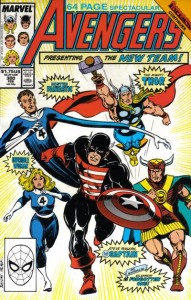 high point is followed by an ending, as Stern gets into a dispute with Avengers editor Mark Gruenwald and leaves the book. After a few substitute-writer issues, though, Walt Simonson comes on board with issue #291 (still with Buscema and Palmer on art), and that team lasts through the anniversary issue #300.
high point is followed by an ending, as Stern gets into a dispute with Avengers editor Mark Gruenwald and leaves the book. After a few substitute-writer issues, though, Walt Simonson comes on board with issue #291 (still with Buscema and Palmer on art), and that team lasts through the anniversary issue #300.
That represents almost the end of the ’80s, though, and the next period is a step down: Mark Gruenwald scripts at first, over artists like Bob Hall and Rich Buckler (although Palmer, still as inker, provides some visual continuity); John Byrne takes over (as writer only; Paul Ryan supplies 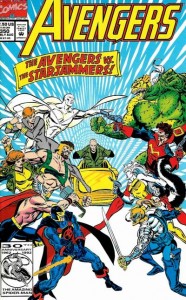 the art) from #305-317 (including a Spider-Man guest stint from #314-317), and then Fabian Nicieza takes over the writing (mostly still with Ryan art) through issue #324. Larry Hama’s next up on the scripting merry-go-round, from #326, and he and Ryan hit a nice little groove up to issue #332; then, Bob Harras (now a DC New52 head editor) begins writing with #334 (over Andy Kubert art in that issue), after which Steve Epting contributes visuals through #339. Other than a few fill-ins, they manage to last for a relatively decent time, including a Galactic Storm crossover in issues #345-347, and finish with the double-sized 350th issue. After a four-issue break, they return with #355 , another nice little
the art) from #305-317 (including a Spider-Man guest stint from #314-317), and then Fabian Nicieza takes over the writing (mostly still with Ryan art) through issue #324. Larry Hama’s next up on the scripting merry-go-round, from #326, and he and Ryan hit a nice little groove up to issue #332; then, Bob Harras (now a DC New52 head editor) begins writing with #334 (over Andy Kubert art in that issue), after which Steve Epting contributes visuals through #339. Other than a few fill-ins, they manage to last for a relatively decent time, including a Galactic Storm crossover in issues #345-347, and finish with the double-sized 350th issue. After a four-issue break, they return with #355 , another nice little 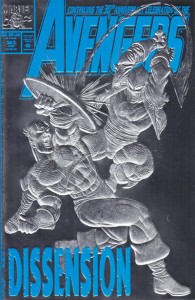 sequence involving a growing romance between the Black Knight and Sersi, and a long-simmering subplot involving rogue extra-dimensional versions of some of the cast that actually manages to hook the reader; today, this run is probably best known for its use of foil covers, in issues #360, 363, 366 and 369, but there’s a good story under those much-mocked ’90s marketing devices, too. The whole thing climaxes in issue #375, after which Epting leaves; the energy level of the title then drops considerably, although it brightens a little with the arrival of Mike Deodato, Jr. on art with issue #381. Deodato hangs around, but there are a lot of fill-in issues, too, and the title reaches its nadir around issue
sequence involving a growing romance between the Black Knight and Sersi, and a long-simmering subplot involving rogue extra-dimensional versions of some of the cast that actually manages to hook the reader; today, this run is probably best known for its use of foil covers, in issues #360, 363, 366 and 369, but there’s a good story under those much-mocked ’90s marketing devices, too. The whole thing climaxes in issue #375, after which Epting leaves; the energy level of the title then drops considerably, although it brightens a little with the arrival of Mike Deodato, Jr. on art with issue #381. Deodato hangs around, but there are a lot of fill-in issues, too, and the title reaches its nadir around issue 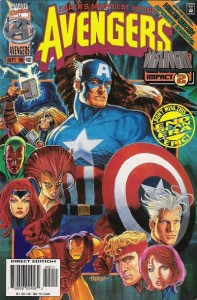 #390, which involves the story “The Crossing,” an incomprehensible tale that decides that Tony Stark has actually been a behind-the-scenes bad guy for years, his mind manipulated by Kang the Conqueror; this ends in Stark’s death in issue #395, after which he’s replaced by a teenaged version of himself from another dimension (stop laughing back there! I’m serious!). The only bright spot is the 400th issue, by Mark Waid and Mike Wieringo; Waid and Deodato contribute issues #401 and 402, which are Onslaught crossovers, and then the first volume of The Avengers limps to its conclusion.
#390, which involves the story “The Crossing,” an incomprehensible tale that decides that Tony Stark has actually been a behind-the-scenes bad guy for years, his mind manipulated by Kang the Conqueror; this ends in Stark’s death in issue #395, after which he’s replaced by a teenaged version of himself from another dimension (stop laughing back there! I’m serious!). The only bright spot is the 400th issue, by Mark Waid and Mike Wieringo; Waid and Deodato contribute issues #401 and 402, which are Onslaught crossovers, and then the first volume of The Avengers limps to its conclusion.
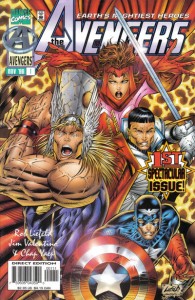 Avengers Volume Two starts just two months later (it’s dated November, 1996), and is the infamous Heroes Reborn experiment, wherein Marvel decides to reboot some of its top titles, farming them out to Image Comics to start over from scratch; for The Avengers, that means leaving the title to the tender mercies of Rob Liefeld; a glance at the cover to the first issue, with its grotesquely-disproportioned characters, helps to show why this was a bad idea. Liefeld co-writes the stories with Jim Valentino and Jeph Loeb, with Chap Yaep (no, I’ve never heard of him before or since, either) providing most of the art; he’s replaced by Ian Churchill with issue #6. By issue #8, Liefeld and his team are gone, replaced by Walt Simonson writing and Michael Ryan drawing, and it’s clear that the outsourcing experiment isn’t going to last: it’s over by the 13th issue, which sets the stage for a return to the “true” Marvel universe.
Avengers Volume Two starts just two months later (it’s dated November, 1996), and is the infamous Heroes Reborn experiment, wherein Marvel decides to reboot some of its top titles, farming them out to Image Comics to start over from scratch; for The Avengers, that means leaving the title to the tender mercies of Rob Liefeld; a glance at the cover to the first issue, with its grotesquely-disproportioned characters, helps to show why this was a bad idea. Liefeld co-writes the stories with Jim Valentino and Jeph Loeb, with Chap Yaep (no, I’ve never heard of him before or since, either) providing most of the art; he’s replaced by Ian Churchill with issue #6. By issue #8, Liefeld and his team are gone, replaced by Walt Simonson writing and Michael Ryan drawing, and it’s clear that the outsourcing experiment isn’t going to last: it’s over by the 13th issue, which sets the stage for a return to the “true” Marvel universe.
The third volume of The Avengers, subtitled “Heroes Return,” begins in February, 1998, and for it Marvel brings their “A” game: writer Kurt Busiek and artist George Perez. The first story takes advantage of Busiek’s encyclopedic knowledge of continuity and Perez’s ability to draw hundreds of characters, as Morgan La Fey has changed the Avengers era to a Camelot-like setting, with dozens of superpowered characters transformed into medieval heroes and villains. This leads into a fourth issue that’s a traditional “choose the team” epilogue, and then into a series of episodes — an encounter with the Squadron Supreme, the introduction of the character 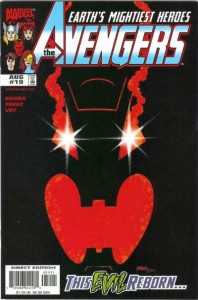 Triathlon, a showdown with the Grim Reaper and then, in the double-sized 12th issue, a crossover with Busiek’s Thunderbolts title; only Perez could draw so many characters and make them all look so good. Perez and Busiek stay on (except for a three-issue fill-in by Jerry Ordway in issues #16-18), and in issue #19 start a major story featuring Ultron (one that fans especially might want to seek out now, in anticipation of Marvel’s upcoming “Age of Ultron” crossover later this year) that runs through issue #22. Perez stays through issue #34, after which a familiar Avengers penciller — Steve Epting — comes in for a few issues, followed by Alan Davis in #s 38-43. Davis is there
Triathlon, a showdown with the Grim Reaper and then, in the double-sized 12th issue, a crossover with Busiek’s Thunderbolts title; only Perez could draw so many characters and make them all look so good. Perez and Busiek stay on (except for a three-issue fill-in by Jerry Ordway in issues #16-18), and in issue #19 start a major story featuring Ultron (one that fans especially might want to seek out now, in anticipation of Marvel’s upcoming “Age of Ultron” crossover later this year) that runs through issue #22. Perez stays through issue #34, after which a familiar Avengers penciller — Steve Epting — comes in for a few issues, followed by Alan Davis in #s 38-43. Davis is there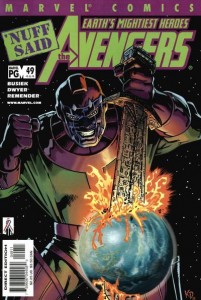 at the beginning of Busiek’s last big story, a long serial involving Kang conquering the Earth (and putting most of the heroes in concentration camps) that runs from issue #41-55, over a year; it’s marred only by a lack of continuity in the art, although Kieron Dwyer handles more of it than anyone else. Issue #56 is Busiek’s last; he’s followed by Geoff Johns, who’s probably best known for his six-part “Red Zone” in issues #65-70, drawn by Oliver Coipel (and second-best known for his opening pages of #71, with its sly, glancing look at the size-changing sex lives of Hank and Janet Pym). Jones and Scott Kolins provide a decent four-part She-Hulk story in issues #72-75, and then in
at the beginning of Busiek’s last big story, a long serial involving Kang conquering the Earth (and putting most of the heroes in concentration camps) that runs from issue #41-55, over a year; it’s marred only by a lack of continuity in the art, although Kieron Dwyer handles more of it than anyone else. Issue #56 is Busiek’s last; he’s followed by Geoff Johns, who’s probably best known for his six-part “Red Zone” in issues #65-70, drawn by Oliver Coipel (and second-best known for his opening pages of #71, with its sly, glancing look at the size-changing sex lives of Hank and Janet Pym). Jones and Scott Kolins provide a decent four-part She-Hulk story in issues #72-75, and then in  issue #77 Chuck Austin comes aboard as writer (with Coipel as artist at first, and then Scott Kolins), and provides mostly-mediocre stories through #84. That’s almost the end of this volume — the next issue reverts to the original numbering, because it’s the 500th, and that debuts current Avengers scribe Brian Michael Bendis and his “Avengers Deconstructed” story, which in four issues shatters the team and clears the way for the next era, New Avengers. That’s a good place to stop for now; as always, most of these issues are available on the discount stands: the earliest are on the back-to-back racks on the west end of the store, near the main checkout stand and my sorting area, while the rest are up front on the racks with the alternate covers, near the new issue section. Everything’s for sale at cover price (minimum $1) — which means all the issues up to #343 are only a buck: a steal for a title with as much history as this one, and a great way to sample its many creative teams and incarnations.
issue #77 Chuck Austin comes aboard as writer (with Coipel as artist at first, and then Scott Kolins), and provides mostly-mediocre stories through #84. That’s almost the end of this volume — the next issue reverts to the original numbering, because it’s the 500th, and that debuts current Avengers scribe Brian Michael Bendis and his “Avengers Deconstructed” story, which in four issues shatters the team and clears the way for the next era, New Avengers. That’s a good place to stop for now; as always, most of these issues are available on the discount stands: the earliest are on the back-to-back racks on the west end of the store, near the main checkout stand and my sorting area, while the rest are up front on the racks with the alternate covers, near the new issue section. Everything’s for sale at cover price (minimum $1) — which means all the issues up to #343 are only a buck: a steal for a title with as much history as this one, and a great way to sample its many creative teams and incarnations.



